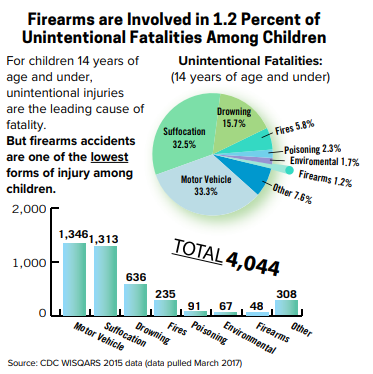 Back to News
Back to News
January 30, 2019
Biased Study Examines Flawed Data for Pre-Determined Conclusion
A new study published in the journal Pediatrics argues that there has been an increase in firearm-related mortality among young children, aged 1-5 years old. The authors blame this on an increase in the proportion of households with handguns versus long guns.
Before we delve into the study’s flaws, it is worth highlighting what the media stories miss. According to the study itself, the results do not show that more families with handguns means more firearm-related fatalities among young children; “The limits of ecological data, therefore, mean our findings should not be interpreted causally.” The authors are also careful to note that “there are likely unmeasured or unobserved covariates that explain the association between firearm ownership and young child firearm-related mortality.” Essentially, the authors are saying – we really can’t prove anything here.
The authors do their best, however, to suggest that a causal relationship DOES exist.
17-Year-Olds Are Now Children?
The study opens with a broad statement that “Firearm-related fatalities are the third leading cause of injury-related death among children aged 0-17 in the United States…” One sentence into the study of those aged 1-5, and the authors are already playing fast and loose with the data. Suddenly, when quantifying the problem, teenagers are lumped in with young children.
As we have written here before, the firearm-related crimes committed by 17-year olds are far different than accidental fatalities among toddlers. It’s incredibly misleading to group these together and assert that one single problem is to blame. Later in the study, the authors do acknowledge that the youngest age group is four times more likely to die by drowning, three times more likely to die in motor vehicle accidents, and still more likely to die by suffocation or in fires, than by a firearm-related cause.
Arguing Without Data
Fortunately, the authors do point out that “the firearm-related mortality rate has declined over the past several decades,” before going on to argue that the decrease has “stagnated” and should be even lower. What’s to blame for this? According to the authors, the problem is that more gun owners are choosing handguns rather than long guns, and because handguns are “more likely to be purchased for personal protection, are more likely to be stored loaded with ammunition.” The only evidence they offer for this is a single, flawed survey from 1997. It’s hard to see how that is relevant to their 2016 findings.
Beyond the biased opening, the entire study is based on a deeply problematic national survey that, as we’ve covered here before, isn’t accurate for a host of reasons. Namely, at certain politically-charged points in time, say after a 1994 federal ban on certain rifles goes into effect, gun owners are less willing to tell random strangers on their doorstep that they own firearms. Of course, having a principle author from New Zealand, it shouldn’t be surprising that the nuance in U.S. polling was missed, and this was chosen as a data set.
No Numbers? Make Some Up
As if the data set weren’t bad enough, it doesn’t cover every year and doesn’t offer sufficient socioeconomic variables, so the authors essentially “guesstimated” the missing points to run the analysis. The analysis itself is odd, in that the goal is to prove a higher percentage of handguns leads to a higher firearm mortality rate among young children. Yet, the fatality data used does not show what type of firearm was tied to each tragic case of a fatality. For all the authors know, handguns could be in the minority for these cases. They do not even attempt to show otherwise.
Here Are the Facts
Regardless of the release of another shaky study on firearms and children, the facts are clear in the publicly-available data, without bringing in biased mathematical gymnastics. Unintentional firearms fatalities are down, as firearms sales are up. If you don’t want to click the link and read for yourself, here are the highlights:
- Firearm-related fatalities in the U.S. have been decreasing since record-keeping began in 1903 – dramatically in the last 20 years, with 2015 being the lowest on record.
- Unintentional firearms-related deaths in the home have dropped by 55.6 percent in the last 20 years.
- From 2014 to 2015, accidental fatalities of all causes increased 8%, while unintentional fatalities related to firearms decreased 17 percent.
- Firearms are involved in fewer than ½ percent (0.3 percent) of all unintentional fatalities in the United States.
- Firearms are involved in just 1.2 percent of unintentional fatalities among children 14 years of age and under and are among the least likely types of unintentional fatalities among children.
- In the last two decades (1995 – 2015), the number of unintentional firearm-related deaths involving children 14 years of age and under has decreased by 73.5 percent.
- From 2005-2015, unintentional firearm-related fatalities declined by 38 percent while firearms ownership grew by an estimated 34 percent.

The firearms industry is committed to making sure accidents continue to decline. Nationally, Project ChildSafe®, which was established in 1998 as a firearms safety education program of the National Shooting Sports Foundation®, the trade association for the firearms industry, has established partnerships with more than 15,000 local law enforcement agencies in communities across the country and engaged more than 8,500 organizational supporters. The program has helped educate firearms owners on the importance of gun safety in communities across all 50 states and five U.S. territories, and distributed more than 38 million free firearms safety kits including a gun lock.
Project ChildSafe Works
A 2017 U.S. Government Accountability Office report concluded that free locking devices positively influenced public behavior to store firearms more safely. Through Project ChildSafe, communities can keep secure firearms storage top of mind year-round.
Rather than rely on faulty logic and even worse data sources, the study authors may wish to revisit their analysis using the facts that accidents are fortunately declining, while firearms sales are growing.
You may also be interested in:
https://www.nssf.org/weak-bloomberg-study-draws-unfounded-conclusions/
Categories: BP Item, Conservation, Featured, Government Relations, Industry News, Top Stories










